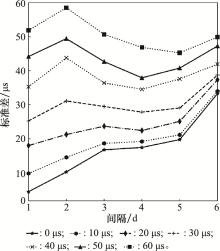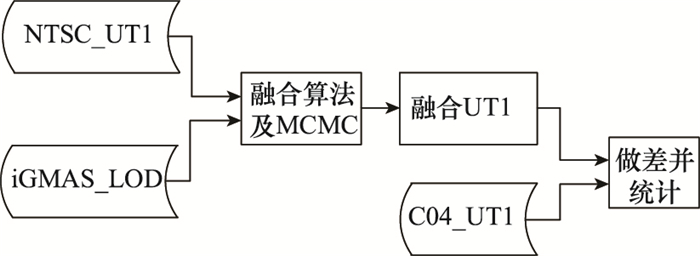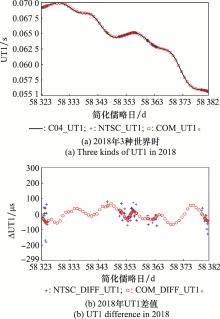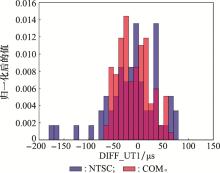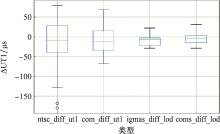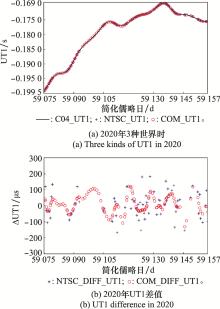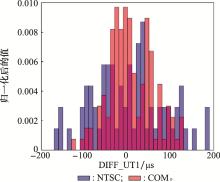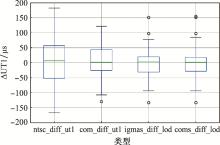Systems Engineering and Electronics ›› 2022, Vol. 44 ›› Issue (5): 1644-1651.doi: 10.12305/j.issn.1001-506X.2022.05.26
• Guidance, Navigation and Control • Previous Articles Next Articles
UT1/ΔLOD data combination method with domestic broadband VLBI2010 system and iGMAS
Xishun LI1,2, Yuanwei WU1,3,*, Dang YAO1,2, Jia LIU1,3, Langming MA1,3, Xuhai YANG1,3, Shougang ZHANG1,4
- 1. National Time Service Center, Chinese Academy of Sciences, Xi'an 710600, China
2. School of Electronic, Electrical and Communication Engineering, University of Chinese Academy of Sciences. Beijing 100049, China
3. Key Laboratory Positioning and Timing Technology, Chinese Academy of Sciences, Xi'an 710600, China
4. Key Laboratory of Time and Frequency Primary Standards, Chinese Academy of Sciences, Xi'an 710600, China
-
Received:2021-06-23Online:2022-05-01Published:2022-05-16 -
Contact:Yuanwei WU
CLC Number:
Cite this article
Xishun LI, Yuanwei WU, Dang YAO, Jia LIU, Langming MA, Xuhai YANG, Shougang ZHANG. UT1/ΔLOD data combination method with domestic broadband VLBI2010 system and iGMAS[J]. Systems Engineering and Electronics, 2022, 44(5): 1644-1651.
share this article
Table 2
Error simulation"
| 采样间隔/d | 误差/μs | ||||||
| 0 | 10 | 20 | 30 | 40 | 50 | 60 | |
| 1 | 4.67 | 9.84 | 18.04 | 25.31 | 35.31 | 44.19 | 51.89 |
| 2 | 10.3 | 14.59 | 21.29 | 31.13 | 43.80 | 49.44 | 58.51 |
| 3 | 16.8 | 18.69 | 23.73 | 29.52 | 36.43 | 42.79 | 50.69 |
| 4 | 17.5 | 19.25 | 22.46 | 27.87 | 34.57 | 37.94 | 46.87 |
| 5 | 19.8 | 21.19 | 25.15 | 29.07 | 37.61 | 40.80 | 45.28 |
| 6 | 33.3 | 34.02 | 37.36 | 38.74 | 41.96 | 47.27 | 49.89 |
| 1 |
高杰, 秦文振, 张金江, 等. 基础序列长度EOP预报精度影响分析[J]. 测绘与空间地理信息, 2020, 43 (9): 134- 135.
doi: 10.3969/j.issn.1672-5867.2020.09.034 |
|
GAO J , QIN W Z , ZHANG J J , et al. Analysis of influence of basic sequence length on the accuracy of EOP prediction[J]. Geomatics & Spatial Information Technology, 2020, 43 (9): 134- 135.
doi: 10.3969/j.issn.1672-5867.2020.09.034 |
|
| 2 |
王广利, 徐明辉. 利用IVS加强观测确定UT1的分析研究[J]. 天文学报, 2012, 53 (3): 222- 229.
doi: 10.3969/j.issn.0001-5245.2012.03.005 |
|
WANG G L , XU M H . The analysis of UT1 determined by IVS intensive observations[J]. Acta Astronomica Sinica, 2012, 53 (3): 222- 229.
doi: 10.3969/j.issn.0001-5245.2012.03.005 |
|
| 3 |
NASTULA J , CHIN T M , GROSS R , et al. Smoothing and predicting celestial pole offsets using a Kalman filter and smoother[J]. Journal of Geodesy, 2020, 94 (3): 2- 17.
doi: 10.1007/s00190-020-01349-9 |
| 4 |
GAMBIS D , LUZUM B . Earth rotation monitoring, UT1 determination and prediction[J]. Metrologia, 2011, 48 (4): 165- 170.
doi: 10.1088/0026-1394/48/4/S06 |
| 5 | 徐天河, 王潜心, 于素梅, 等. 利用区域网GPS/BDS数据确定地球自转参数[J]. 导航定位学报, 2015, 3 (3): 13- 17. |
| XU T H , WANG Q X , YU S M , et al. Earth rotation parameters determination using local GPS/BDS network data[J]. Journal of Navigation and Positioning, 2015, 3 (3): 13- 17. | |
| 6 | 张永浩, 成英燕, 王虎, 等. BDS与GPS数据解算地球自转参数精度分析[J]. 测绘科学, 2018, 43 (12): 13- 14. |
| ZHANG Y H , CHENG Y Y , WANG H , et al. Analysis of earth rotation parameters accuracy based on BDS and GPS data[J]. Science of Surveying and Mapping, 2018, 43 (12): 13- 14. | |
| 7 | BIZOUARD C, GAMBIS D. The combined solution C04 for earth orientation parameters consistent with international terrestrial reference frame 2005[C]//Proc. of the International Association of Geodesy Symposium, 2009: 265-270. |
| 8 | GAMBIS D . Monitoring earth orientation using space-geodetic techniques: state of the art and prospective[J]. Journal of Geodesy, 2004, 78 (4): 295- 303. |
| 9 |
RAY J , KAUBA J , ALTAMIMI Z . Is there utility in rigorous combinations of VLBI and GPS earth orientation parameters?[J]. Journal of Geodesy, 2005, 79 (9): 505- 511.
doi: 10.1007/s00190-005-0007-7 |
| 10 | FERLAND R , PIRASZEWSKI M . The IGS combined stations coordinates, earth rotation parameters and apparent geocenter[J]. Journal of Geodesy, 2009, 83 (5): 385- 392. |
| 11 |
THALLER D , KRUGEL M , ROTHACHE M , et al. Combined earth orientations parameters based on homogeneous and continuous VLBI and GPS data[J]. Journal of Geodesy, 2007, 81 (8): 529- 541.
doi: 10.1007/s00190-006-0115-z |
| 12 |
ARTZ T , BERNHARD L , NOTHNAGEL A , et al. Methodology for the combination of sub-daliy earth rotation from GPS and VLBI observations[J]. Journal of Geodesy, 2012, 86 (3): 221- 239.
doi: 10.1007/s00190-011-0512-9 |
| 13 | 郝亮, 章传银. 地球自转参数的空间大地测量方法探讨[J]. 科技与创新, 2017, (2): 7- 8. |
| HAO L , ZHANG C Y . Discussion on space geodesy method of earth rotation parameters[J]. Science and Technology & Innovation, 2017, (2): 7- 8. | |
| 14 |
MALKIN Z . The impact of celestial pole offset modelling on VLBI UT1 intensive result[J]. Journal of Geodesy, 2011, 85 (9): 617- 622.
doi: 10.1007/s00190-011-0468-9 |
| 15 | LIU X X, WEI E H, WANG L X. Calculating high frequency earth rotation parameters using GPS observations and precision analysis[C]//Proc. of the 8th China Satellite Navigation Conference, 2017: 32-42. |
| 16 | 张志斌, 王广利, 刘祥, 等. 中国VLBI网观测地球定向参数能力分析[J]. 武汉大学学报, 2013, 38 (8): 911- 915. |
| ZHANG Z B , WANG G L , LIU X , et al. Analysis of EOP determination via Chinese VLBI network[J]. Geomatics and Information Science of Wuhan University, 2013, 38 (8): 911- 915. | |
| 17 | 张军杰. 联合VLBI和GNSS解算地球自转参数方法及软件实现[D]. 北京: 中国矿业大学, 2018. |
| ZHANG J J. Estimation of earth rotation parameters based on the combination of VLBI and GNSS technologies and its software realization[D]. Beijing: China University of Mining and Technology, 2018. | |
| 18 |
王广利, 李金岭, 钱志瀚, 等. 利用天测与测地VLBI观测建立天球与地球参考架[J]. 测绘学报, 2000, 29 (2): 114- 117.
doi: 10.3321/j.issn:1001-1595.2000.02.004 |
|
WANG G L , LI J L , QIAN Z H , et al. The determinations of celestial and terrestrial reference frames from astrometric and geodetic VLBI observations[J]. Acta Geodaetica et Cartographica Sinica, 2000, 29 (2): 114- 117.
doi: 10.3321/j.issn:1001-1595.2000.02.004 |
|
| 19 |
WEI E H , YAN W , JIN S G , et al. Improvement of earth orientation parameters estimate with Chang'E-1 delta VLBI observations[J]. Journal of Geodynamics, 2013, 72, 46- 52.
doi: 10.1016/j.jog.2013.04.001 |
| 20 | 魏二虎, 刘文杰, WEIJianan, 等. VLBI和GPS观测联合解算地球自转参数和日长变化[J]. 武汉大学学报(信息科学版), 2016, 41 (1): 66- 71. |
| WEI E H , LIU W J , WEI J N , et al. Calculation of earth rotation parameters and day length variation by joint observation[J]. Geomatics and Information Science of Wuhan University, 2016, 41 (1): 66- 71. | |
| 21 | GAMBIS D, BIZOUARD C. Monitoring UT1 from astro-geodetic techniques at the EOP Center of the IERS[C]//Proc. of the 28th IAU General Assembly, 2009: 207-208. |
| 22 | GAMBIS D, BIZOUARD C. Monitoring UT1 using both VLBI and GPS estimates[C]//Proc. of the 19th European VLBI for Geodesy and Astrometry Working Meeting, 2009: 24-25. |
| 23 |
FREEDMAN A P , STEPPE J A , DICKEY J O , et al. The short-term prediction of universal time and length of day using atmospheric angular-momentum[J]. Journal of Geophysical Research-Solid Earth, 1994, 99 (B4): 6981- 6996.
doi: 10.1029/93JB02976 |
| 24 |
SENIOR K , KOUBA J , RAY J . Status and prospects for combined GPS LOD and VLBI UT1 measurements[J]. Artificial Satellites, 2010, 45 (2): 57- 72.
doi: 10.2478/v10018-010-0006-7 |
| 25 | NILSSON T , KARBON M , SOJA B , et al. Rapid UT1 estimation by combining VLBI intensives with GNSS[J]. International Association of Geodesy Symposia, 2016, 150 (143): 521- 526. |
| 26 |
VONDRAK J , CEPEK A . Combined smoothing method and its use in combining Earth orientation parameters measured by space techniques[J]. Astronomy & Astrophysics, 2000, 12 (1): 347- 359.
doi: 10.1051/aas:2000306 |
| 27 | 曾安敏, 张琦, 孙中苗. 一种附加边界约束和内约束的多中心ERP融合模型[J]. 武汉大学学报(信息科学版), 2019, 44 (12): 1771- 1776. |
| ZENG A M , ZHANG Q , SUN Z M . A multicenter ERP fusion model with boundary and internal constraints[J]. Geomatics and Information Science of Wuhan University, 2019, 44 (12): 1771- 1776. | |
| 28 | VONDRAK J . A contribution to the problem of smoothing observational data[J]. Bulletin of the Astronomical Institutes of Czechoslovakia, 1969, 20 (6): 349- 355. |
| 29 | VONDRAK J . Problem of smoothing observational data Ⅱ[J]. Bulletin of the Astronomical Institutes of Czechoslovakia, 1977, 28 (2): 84- 89. |
| 30 | 曹梦成, 朱建军, 邹峥嵘, 等. Vondrak滤波在周跳探测与修复中的应用[J]. 工程勘察, 2006, (10): 54- 56. |
| CAO M C , ZHU J J , ZOU Z R , et al. Application of Vondrak filter in cycle slip detection and repair[J]. Journal of Geotechnical Investigation & Surveying, 2006, (10): 54- 56. | |
| 31 |
VAJARGAH K F , BENIS S G , GOLSHAN H M . Detection of the quality of vital signals by the Monte Carlo Markov chain (MCMC) method and noise deleting[J]. Health Information Science and Systems, 2021, 9 (1): 2- 10.
doi: 10.1007/s13755-020-00135-3 |
| 32 |
HU G Y , WANG H Y . Most likely optimal subsampled Mar-kov chain Monte Carlo[J]. Journal of Systems Science & Complexity, 2021, 34 (3): 1121- 1134.
doi: 10.1007/s11424-020-9335-1 |
| 33 |
LIAO M Y . Efficient technique for assessing actual non-normal quality loss: Markov chain Monte Carlo[J]. Quality and Reliability Engineering International, 2017, 33 (5): 945- 957.
doi: 10.1002/qre.2071 |
| 34 |
XU S F , XIE L , LIU J L . Robot localization based on MCMC particle filter[J]. Journal of Zhejiang University (Engineering Science), 2007, 41 (7): 1083- 1087.
doi: 10.1007/s10483-007-0613-x |
| 35 |
HUFFER F W , WU H L . Markov chain Monte Carlo for autologistic regression models with application to the distribution of plant species[J]. Biometrics, 1998, 54 (2): 509- 524.
doi: 10.2307/3109759 |
| 36 |
HAARIO H , SAKSMAN E , TAMMINEN J . Componentwise adaptation for high dimensional MCMC[J]. Computational Statistics, 2005, 20 (2): 265- 273.
doi: 10.1007/BF02789703 |
| 37 |
MALKIN Z . Impact of seasonal station motions on VLBI UT1 intensives results[J]. Journal of Geodesy, 2013, 87 (6): 505- 514.
doi: 10.1007/s00190-013-0624-5 |
| 38 |
MACMILLAN D S . EOP and scale from continuous VLBI observing: CONT campaigns to future VGOS networks[J]. Journal of Geodesy, 2017, 91 (7): 819- 829.
doi: 10.1007/s00190-017-1003-4 |
| 39 | 姚当, 弓剑军, 马浪明, 等. 基于VGOS系统的UT1初步观测与计算[J]. 时间频率学报, 2018, 41 (3): 234- 240. |
| YAO D , GONG J J , MA L M , et al. The preliminary test observation of UT1 with the VGOS system[J]. Journal of Time and Frequency, 2018, 41 (3): 234- 240. | |
| 40 |
YAO D , WU W W , ZHANG B , et al. The NTSC VLBI system and its application in UT1 measurement[J]. Research in Astronomy and Astrophysics, 2020, 20 (6): 153- 162.
doi: 10.1088/1674-4527/20/6/93 |
| [1] | SHENG Han-lin, ZHANG Tian-hong, LIU Dong-dong. Low-cost AHRS design based on extending Kalman filter [J]. Systems Engineering and Electronics, 2013, 35(10): 2158-2164. |
| Viewed | ||||||
|
Full text |
|
|||||
|
Abstract |
|
|||||


